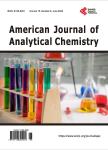Microwave-Assisted Au and Ag Nanoparticle Synthesis: An Energy Phase-Space Projection Analysis
Microwave-Assisted Au and Ag Nanoparticle Synthesis: An Energy Phase-Space Projection Analysis作者机构:School of Mechanical and Materials Engineering University College Dublin Dublin Ireland
出 版 物:《American Journal of Analytical Chemistry》 (美国分析化学(英文))
年 卷 期:2023年第14卷第4期
页 面:149-174页
学科分类:081704[工学-应用化学] 07[理学] 08[工学] 0817[工学-化学工程与技术] 070303[理学-有机化学] 0703[理学-化学]
主 题:Turkevich Microwave-Assisted Synthesis Ag Au Hydroxyapatite Nanoparticle Functionalization Energy Phase-Space Projection
摘 要:Microwave-assisted synthesis of gold and silver nanoparticles, as a function of Green Chemistry, non Green Chemistry, and four applicator types are reported. The applicator types are Domestic microwave ovens, commercial temperature controlled microwave chemistry ovens (TCMC), digesters, and axial field helical antennae. For each of these microwave applicators the process energy budget where estimated (Watts multiplied by process time = kJ) and energy density (applied energy divided by suspension volume = kJ·ml-1) range between 180 ± 176.8 kJ, and 79.5 ± 79 kJ·ml-1, respectively. The axial field helical field an-tenna applicator is found to be the most energy efficient (0.253 kJ·m-1 per kJ, at 36 W). Followed by microwave ovens (4.47 ± 3.9 kJ·ml-1 per 76.83 ± 39 kJ), and TCMC ovens (2.86 ± 2.3 kJ·m-1 per 343 ± 321.5 kJ). The digester applicators have the least energy efficiency (36.2 ± 50.7 kJ·m-1 per 1010 ± 620 kJ). A comparison with reconstructed ‘non-thermal’ microwave oven inactivation microorganism experiments yields a power-law signature of n = 0.846 (R2 = 0.7923) four orders of magnitude. The paper provides a discussion on the Au and Ag nanoparticle chemistry and bio-chemistry synthesis aspects of the microwave applicator energy datasets and variation within each dataset. The visual and analytical approach within the energy phase-space projection enables a nanoparticle synthesis route to be systematically characterized, and where changes to the synthesis are to be mapped and compared directly with historical datasets. In order to help identify lower cost nanoparticle synthesis, in addition to potentially reduce synthesis energy to routes informed changes to potentially reduce synthesis energy budget, along with nanoparticle morphology and yield.



